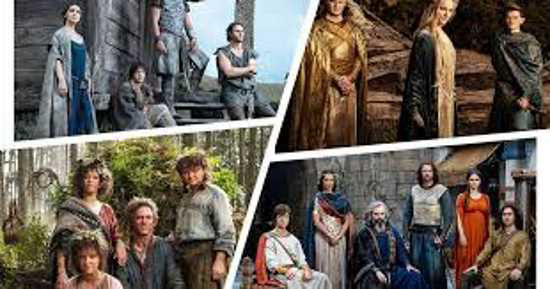4 mins read//
In Tudor times, the printing of vernacular Bibles dethroned Latin as the language of Christian faith. In Númenor, too, language is a battleground, with Quenya—which Tolkien called “Elf-latin”—being driven underground in favor of a human language.
/https://tf-cmsv2-smithsonianmag-media.s3.amazonaws.com/filer_public/31/50/315029f0-00dc-4dac-acc0-c15a631a34a0/oct2022_e02_tolkien.jpg)
In Númenor, such events do come to pass. “The Lost Road” is a time-travel story in which, via dream, 20th-century observers witness Númenor’s fall. Tolkien’s anger feels live and burning. Christopher Tolkien later said, “When at this time my father reached back to the world of the first man to bear the name ‘Elf-friend’ he found there an image of what he most condemned and feared in his own.”
Elendil catalogs the rabid construction of arms and warships, whispered denunciations, disappearances, torture behind closed doors. He blames Númenor’s evils squarely on Sauron. In The Silmarillion, Sauron had been a shape-shifting lord of werewolves, quite different from the sinister manipulator who emerges in “The Lost Road.” Even some of the details are reminiscent of Hitler’s policies. In a mirror-image of Nazi demands for Lebensraum (living space), Sauron’s acolytes in Númenor want “to conquer new realms for our race, and ease the pressure of this peopled island.”
Later, Tolkien would declare a “burning private grudge...against that ruddy little ignoramus Hitler” who had hijacked Tolkien’s beloved Northern European mythology for propaganda purposes. Likewise, Sauron twists the story of why Númenor’s national forefather, Eärendil, sailed to the Undying Lands at the end of the First Age: Eärendil had actually made the journey to beg the Valar’s aid against Morgoth, but in Sauron’s revisionist version, he’d gone to seize unending life for himself. The colossal temple to Morgoth even strikingly parallels the plans laid by Hitler’s architect, Albert Speer, for a Volkshalle (people’s hall).
/https://tf-cmsv2-smithsonianmag-media.s3.amazonaws.com/filer_public/eb/0b/eb0b104d-49c7-417d-b754-24a7db6c38cb/oct2022_e03_tolkien.jpg)
By 1936, Tolkien was well acquainted with tragedy. After his mother died when he was 12, Tolkien had felt “like a lost survivor into a new alien world after the real world has passed away.” He felt the same in 1935 on the death of his guardian, Father Francis Morgan, the man he called his “second father.”
Tolkien abandoned “The Lost Road” in 1937 when The Hobbit’s publishers demanded the sequel that eventually became The Lord of the Rings. But Tolkien returned to work on Númenor just after the Second World War. A new story—also sadly unfinished—involved a clique of Oxford dons very much like the Inklings, a group of literary friends Tolkien shared with C.S. Lewis. Memorably, one of Tolkien’s fictional 20th-century academics has a vision of the Radcliffe Camera—part of Oxford’s great Bodleian Library—as the temple of Morgoth, with the smoke of human sacrifice pouring from its louvers. The enemy is now at the heart of the realm: The story reads like an aftertaste of the invasion fear that Britons had endured in the intervening years.
/https://tf-cmsv2-smithsonianmag-media.s3.amazonaws.com/filer_public/37/e1/37e1780f-bdcb-4885-9c25-240578c70102/oct2022_e11_tolkien.jpg)
Meanwhile, Tolkien continued developing the vast history of his fictional world. After Númenor’s destruction, Elendil leads the faithful to safety and establishes, with his sons, the twin kingdoms of Arnor and Gondor. From a high hilltop tower—surely inspired by one at Faringdon near Oxford built in 1935—he gazes out over the seas toward the lost world that had been Númenor. In the Third Age, Aragorn, the hobbits’ wandering companion and king-to-be (played by Viggo Mortensen in the films), will be Elendil’s direct descendant and heir.
Looking at the evidence, it is clear that Hitler and other 1930s despots were very relevant to Tolkien’s Númenor stories and his all-important equation of Sauron with tyranny. Yet Tolkien officially denied that The Lord of the Rings was an allegorical code for the Second World War. How do we square this circle?
In the foreword to the 1966 edition of The Fellowship of the Ring, the first book in the trilogy, Tolkien wrote, “I cordially dislike allegory in all its manifestations, and always have done so since I grew old and wary enough to detect its presence. I much prefer history, true or feigned, with its varied applicability to the thought and experience of readers. I think that many confuse ‘applicability’ with ‘allegory’; but the one resides in the freedom of the reader, and the other in the purposed domination of the author.”
/https://tf-cmsv2-smithsonianmag-media.s3.amazonaws.com/filer_public/c1/e1/c1e18caf-6638-4268-acc4-56746ab4779e/oct2022_e17_tolkien.jpg)
In this, he has succeeded. As Amazon Studios’ senior development executive Kevin Jarzynski says, Tolkien’s work is not “about one specific moment in time but a repetition of history. There are some lessons that we as a people are always trying to learn about power, about temptation, time and time again.” The key message of Númenor, as timely now as ever, is that the lust for power leads to wholly avoidable disaster.











